![]()
![]()
![]()
Use LEFT and RIGHT arrow keys to navigate between flashcards;
Use UP and DOWN arrow keys to flip the card;
H to show hint;
A reads text to speech;
14 Cards in this Set
- Front
- Back
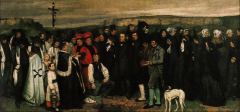
|
"BURIAL AT ORNANS," GUSTAVE COURBET (1849); OIL ON CANVAS, MUSEE D' ORSAY. PARIS, FRANCE.
Shows a dreary sky along with a freshly dug grave. There is a large depiction of emotion. |
|
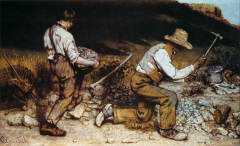
|
"THE STONE BREAKERS," GUSTAVE CORBET (1849); OIL ON CANVAS, DRESDEN, GERMANY.
Epitome of realist spirit, and comments on systematic poverty. Depicts men honestly and accurately. |
|
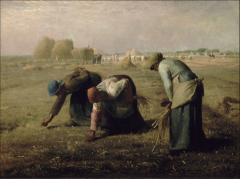
|
"THE GLEANERS," JEAN-FRANCOIS MILLET (1857); OIL ON CANVAS, MUSEE D' ORSAY. PARIS, FRANCE.
Women picking up shod wheat, and has a soft and subdued palette. Jean depicted primarily peasants and farmworkers. |
|
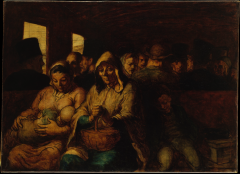
|
"THIRD-CLASS CARRIAGE," HONORE DAUMIER (1862); OIL ON CANVAS, METROPOLITAN MUSEUM OF ART. NEW YORK CITY.
Depicts four French women, and emphasizes the bleakness and emnity. One of the first accurate depictions of breast feeding. |
|
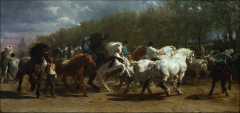
|
"THE HORSE FAIR," ROSA BONHEUR (1853-55); OIL ON CANVAS, METROPOLITAN MUSEUM OF ART. NEW YORK CITY.
The first female artist to win the Legion of Honor, and she mainly depicted people, events, and animals. |
|
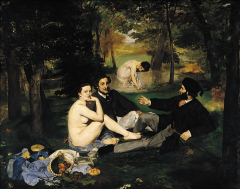
|
"LUNCHEON ON THE GRASS," EDOUARD MANET (1863); OIL ON CANVAS, MUSEE D' ORSAY. PARIS, FRANCE.
References to the "Pastoral Symphony," and stressed his presence through brush strokes. |
|
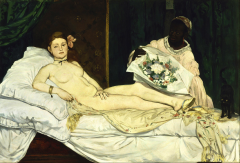
|
"OLYMPIA," EDOUARD MANET (1863); OIL ON CANVAS, MUSEE D' ORSAY. PARIS, FRANCE.
Olympia was commonly a name for a prostitute, and is a reference to Venus. Incited racism in the comparison of a slave to prostitute. |
|
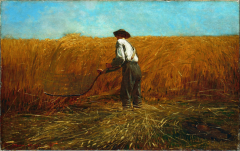
|
"VETERAN IN A NEW FIELD," WINSLOW HOMER (1865); OIL ON CANVAS, METROPOLITAN MUSEUM OF ART, NEW YORK CITY.
Realistically depicts returned soldier after the Civil War, and sadness because of the devastation of the war and maybe Lincoln's death. |
|
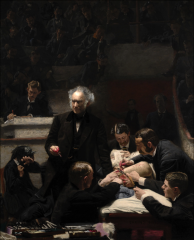
|
"THE GROSS CLINIC," THOMAS EAKINS (1875); OIL ON CANVAS, PHILADELPHIA MUSEUM OF ART. PHILADELPHIA, PENNSYLVANIA.
Worked in a documentary style, and references to "The Anatomy of Dr. Tulp," and glorifies the innovation and progressiveness of science. |
|
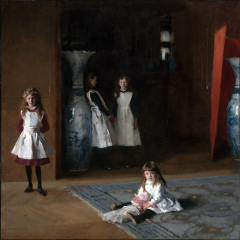
|
"THE DAUGHTERS OF EDWARD DARLEY BOIT," JOHN SINGER (1882); OIL ON CANVAS, MUSEUM OF FINE ARTS. BOSTON MASSACHUSETTS.
Shows a sense of personality with each daughter and a sense of spontinaety. |
|
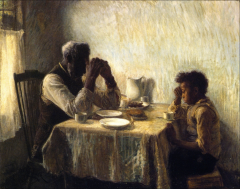
|
"THE THANKFUL POOR," HENRY OSSAWA TANNER (1894); OIL ON CANVAS. COLLECTION OF BILL COSBY AND CAMILLE COSBY.
Henry was the first black student at the Pennsylvania Academy of Fine Arts. There is a religious overtone drawn from the golden light. |
|
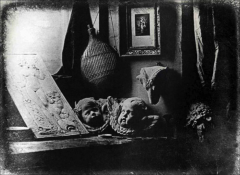
|
"STILL LIFE IN STUDIO," LOUIS-JACQUES-MANDE DAGUERRE (1837); DAHUERREOTYPE, SOCIETE FRANCAISE DE PHOTOGRAPHIE. PARIS, FRANCE.
Shows that the purpose of photography had always been for the purpose of art. |
|
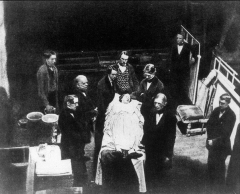
|
"EARLY OPERATION UNDER ETHER, MASSACHUSETTS GENERAL HOSPITAL," JOSIAH HAWES (1847); DAGUERREOTYPE, MASSACHUSETTS GENERAL HOSPITAL ARCHIVES AND SPECIAL COLLECTIONS. BOSTON MASSACHUSETTS.
Demonstrates surgery while the patient is under ether, and is taken from the perspective of the students. |
|

|
"A HARVEST OF DEATH, GETTYSBURG, PENNSYLVANIA," TIMOTHY O' SULLIVAN (1863); ALBUMEN PRINT. NEW YORK PUBLIC LIBRARY. NEW YORK CITY.
Photo showed he devastation and horror s of war and he photo is taken from level view. Sometimes the bodies were curated. |

